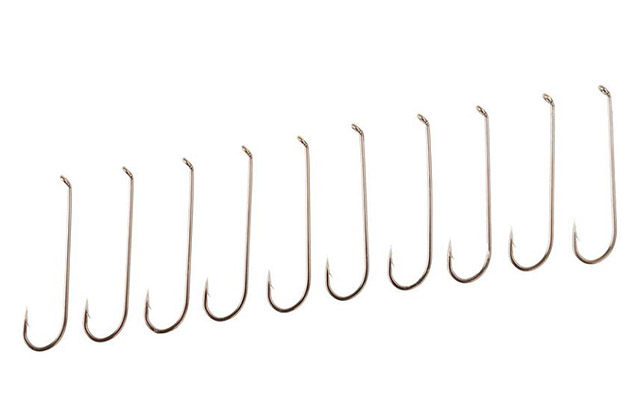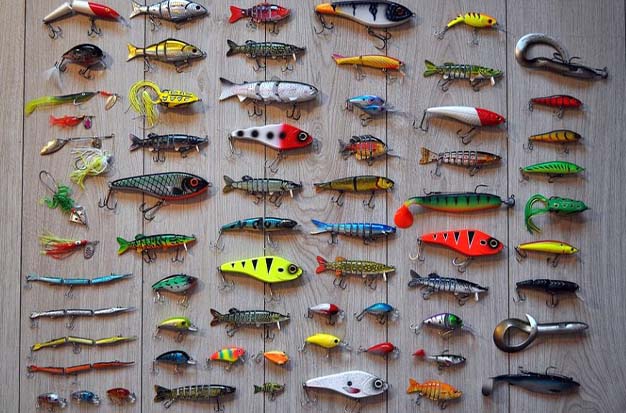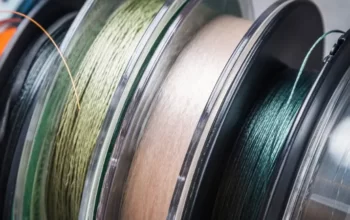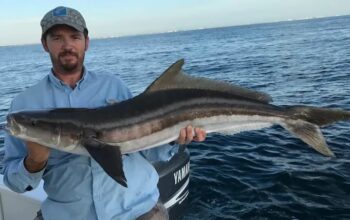A variety of sizes and styles of hooks are available that can be used to catch anything from a minnow to a marlin. Additionally, there are numerous colors for hooks. Despite the wide variety of options, a few standard sizes and types will probably satisfy all of your freshwater and saltwater fishing demands.
In addition to the most popular hook styles and their applications, this article will examine hook sizes and types.
Table of Contents
What Is A Fishing Hook Size?
A fishing hook’s size can be determined by counting the distance between its point and shank.
The four parts of a fishing hook are the shank, point, barb, and eye. The length of a fishing hook that is straight is called the shank. The gap (the area between the tip and shank that is carved out) is where it begins, and it terminates close to where it meets the eye. Your bait can’s size.
The most important part of a fishing hook is its tip, which allows you to pierce an animal’s mouth in order to catch fish. Additionally, it makes or affects how easy it will be for an angler to remove a fish that has been caught from the water. The point of a good fishing hook should be sharp, thin, and robust.
The barb, a little protrusion on the shank’s bottom, prevents any predator from removing your bait once it has been hooked. Your capture will be better protected during a heated conflict with a fish or other predator the thicker its diameter.
The end of the line or lure that attaches to a fishing hook is called the eye, and it is commonly made of stainless steel. The way an angler makes their knots also has an impact on how securely a fishing hook remains attached during your entire outdoor adventure.
Types Of Hook Eye
To put it bluntly, picking the appropriate eye can have a significant impact on your catch rate. For specialized knots and tying techniques, there are particular eyes. To withstand the stress of major fights, certain eyes are additionally fortified.
The most typical is just a ringed eye. It works with a variety of knots and is simple to thread line through. Anglers typically employ a brazed eye, which is a loop that is soldered shut with molten metal, for larger fish. A hook is prevented from bending or breaking by brazing. Finally, fishing with bait is best done with needle eye hooks. Like a sewing needle, the entire hook may be simply threaded through the bait fish.
Additionally, there are a few eyes that you may only use with particular fishing methods. A tapering eye, which becomes more narrow toward the end of the loop, is the holy grail of dry fly fishermen. This helps the fly float properly by reducing the weight. Wet flies are given a little additional weight on the other end of the scale by having a looped eye. Additionally, it enables fly tyers to be more imaginative with their creations.
Types Of Hook Point
The core of your entire arrangement is here. It makes the difference between a successful connection and a close call. So it comes as no surprise that different hook points have been created over time. The following are the top five ideas.
Knife Edge Point
These guys are serious. They are designed for optimum penetration and have been sharpened on both sides and pointed away from the shank. Knife edge tips have the drawback of seriously hurting the fish.
Needle Point
Needle points taper in slightly towards the shank. They are made to penetrate through the material easily and leave behind little harm. As a result, the fish suffers less damage and finds it more difficult to throw the hook.
Spear Point
This is the most common point and a great all-rounder. Spear points run straight up from the throat, giving you decent penetration and limited damage to the fish. They’re also easier to sharpen than more elaborate varieties.
Hollow Point
Hollow point hooks have a bent-in spike that curves down to the barb. They cut through soft-mouthed fish and stay in place once they’re there. However, they can make setting the hook much more difficult on tougher species.
Rolled in Point
Rolling in the points allows for the most penetration force. The tip points in the direction of the eye of the hook, keeping your force parallel to the path through the mouth of a fish. They are ideal for fish that struggle when brought to the boat.
Fishing Hook Sizes
Finding the ideal hook size ought to be simple. You just determine the appropriate size hook for your chosen species by consulting a standard table of hook sizes, right? Sadly, life is rarely that simple. Instead, selecting one requires you to sift among a dozen distinct metrics. The most significant ones and their meaning are listed below.
In general, fishing hook sizes begin in the center and move outward. You can see sizes on the left. You have “aughts” on the right.
There are many sizes of hooks, with size 30 being the smallest. Size 29 is the next smallest, followed by 28, 27, and so on, “up” to size 1. Size 1 is followed by size 1/0 (pronounced “one aught”), 2/0, 3/0, and so on, all the way up to size 27/0, which is likely used to catch actual sea monsters.
It’s important to note that there is no accepted definition of “real size.” A 1/0 circular hook and a 1/0 jig hook will not have the same size. More significantly, it greatly differs by brand. An Eagle Claw 1/0 jig hook will likely be larger than a Gamakatsu equivalent, but smaller than a Mustad equivalent. And one of the measurements not taken is size.

Common Types of Fish Hooks and Their Uses
You probably already know that there are dozens, if not hundreds, of various fishing hooks if you’ve ever spent any time in a tackle shop. Each has a purpose, and occasionally even the most peculiar designs are useful. A self-respecting angler should carry a few certain sorts of fishing hooks in their tackle box, though. This is our condensed list.
Worm Hooks
If you enjoy using plastic worms when fishing, worm hooks and you are definitely close buddies. The “head” of the worm is held in place by the bend near the eye. The point punctures the body as it waits to seize onto unwary fish. The remainder of the lure hangs limply. This permits natural and unhindered movement.
Bait Holder Hooks
Bait holds ensure that your bait doesn’t fall off the hook, as would be expected. Both the barbs on the shank, which hold the bait in place and the barbed point, which latches onto any fish that bites the bait, are present. Although bait holders are very effective, their barbs can also do a lot of harm. If you want to release your fish, they’re not the best option.
Circle Hooks
The closest you can go to “fish-friendly” gear is with circle hooks. This prevents them from “deep hooking” a fish’s throat or gut by bending the point inward toward the shank. Instead, they snag in the mouth’s corner. Circle hooks are difficult to use at first. Before applying pressure, you must wait until they are firmly seated to prevent pulling them out of the fish’s mouth.
Jig Hooks
An angler on a boat with blue sunglasses and a black cap. A soft plastic lure is protruding from the striper’s mouth while it is being held by the angler. He can see the sky and the sea behind him.
These men are as straightforward as they are successful. To improve the movement of the lure in the water, the eye is positioned at a right angle to the shank. By removing or filing down the barb on the point, jig hooks can easily be modified for catch and release.
Weedless Hooks
Bass anglers from all over the world favor weedless hooks. They are employed in lakes and ponds where there is a lot of foliage while you are fishing. The point is protected by a small guard that clips on. This prevents you from taking out half the pond with each retrieval. As soon as a fish catches your bait, it will immediately come off because it is only loosely fixed on.
Kahle Hooks
Aberdeens are at one end of the scale, and Kahle hooks are at the other. They were made for large baits and difficult fights thanks to their robust build and extremely wide gape. Kahle hooks resemble circle hooks in appearance, however, the point doesn’t curve inward toward the shank. Instead, it looks directly up at the eye, which makes them simpler to set.
Treble Hooks
Are you going to throw topwater lures or storm a castle? Treble hooks are required. As one of them will always be facing the appropriate direction, three points equal three times as many opportunities for a hookup. Trebles have the drawback of not penetrating very deeply. They can also be challenging to unhook yourself from without realizing it.
Siwash Hooks
Since siwash hooks are simpler to remove and less destructive to fish than treble hooks, many fishermen substitute them for treble hooks when making spinnerbaits or poppers. They have an open eye for simple attachment as a result. Longshanks and points enable siwashes to hang naturally off your lure and remain in place once they have set.
Aberdeen Hooks
Since the beginning of fishing as a pastime, Aberdeen hooks have been widely employed in the isolated salmon streams of northeast Scotland. Their long shank and light wire allow you to safely attach small live baits without endangering them. They continue to live because of this.
Octopus Hooks
One thing was on the minds of those who created octopus hooks: how to display small baits organically. While reducing size and weight, their small, rounded shank still has adequate gape to hook larger fish. On an octopus hook, the point bends in slightly, but not as much as on circle hooks.
How To Know What Size Of Hook You Need?
Fishing hook sizes can be quite small if you are targeting smaller fish, but they must be larger if you are targeting saltwater or freshwater lakes and rivers.
There isn’t really a “one size fits all” solution when attempting to figure out what size fishing hook you need because fishing is an art form.
There are fishing hook sizes that can be used to catch enormous species like sharks as well as fishing hook sizes that can fit into a child’s fishing equipment, thus the range is fairly broad.
Searching for a fishing hook size chart is one of the finest ways to figure out what size fishing hook you’ll need for your upcoming fishing excursion.
Conclusion
The most basic component of your setup is, in principle, your fishing hooks. They don’t have to be composed of some kind of advanced carbon fiber or be submerged in invisibility. They are simply bent pieces of metal with a sharp edge.
Hooks have, however, been honed and refined into a thousand different variations, just like everything else in fishing. A purpose serves each component. Each fashion has its place. A certain method to step up your game and, ideally, increase your catch rate is to know what to use.
Read more about: How To Tie A Fishing Hook (A Complete Guide For Beginners)




